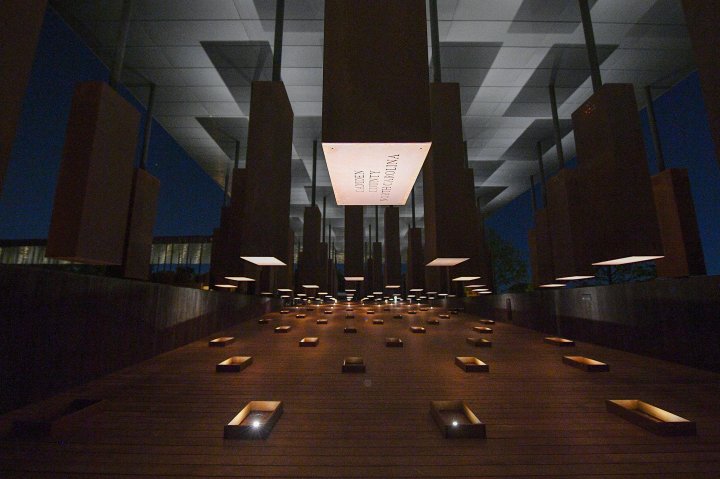Most public memorials exalt history. Deep in the American South, a powerful space pays homage to its victims. At a low angle, the roof of the National Memorial for Peace and Justice appears to be held up by columns. Draw closer, and it emerges that the more than 800 Corten steel slabs are in fact hanging from the ceiling. Inscribed on each is the name of a county, followed by dates and names of persons, some marked unknown. They honor approximately 4,400 black Americans who were murdered in lynchings between 1877 and 1950. The first-of-its-kind memorial was created by the Equal Justice Initiative (EJI), a legal advocacy group founded by Bryan Stevenson, in collaboration with MASS Design Group; EJI also runs the nearby Legacy Museum, devoted to the full gamut of America’s racial history. Both sites are resonating: more than 100,000 people have visited since they opened in April. —Merrill Fabry
Greatest Places
Full List
To Visit
Tianjin Binhai LibraryCycling Through WaterMorgan's Inspiration IslandGolden BridgeTippet Rise Art CenterPandora: The World of AvatarElbphilharmonieMuseum MACANSeoullo 7017 SkygardenCentral Idaho Dark Sky ReserveThreadZaryadye ParkUnderwater Museum of ArtMariposa GroveTai KwunAustin Central LibraryChangChui: Creative ParkCasa VicensAl-Qarawiyyin LibraryDesign SocietyLöylySunder NurseryTivoli GardensKing Abdulaziz Center for World CultureLascaux International Center for Cave ArtExperimentariumTeopanzolco Cultural CenterThe National Memorial for Peace and JusticeTemple of MithrasLouvre Abu DhabiOriental Science Fiction ValleyGovernors IslandWarner Bros. World Abu DhabiZeitz MOCAATo Stay
Giraffe ManorViceroy Los CabosAlila Fort BishangarhConrad Maldives Rangali IslandCOO Boutique Hostel & SociatelMarriott Mena HouseSnow Bear ChaletsPonant Le LapérouseAmanyangyunTreehotelHôtel de CrillonSix Senses FijiConscious Hotel WesterparkViking OrionIl SerenoWilderness Safaris Bisate LodgeAtix HotelJackalopeIlla Experience HotelIcehotel 365The CollectionistGenerator MadridMorpheus HotelRaffles Europejski WarsawSkwachàys LodgeEcoCamp PatagoniaCasa TeoNorwegian BlissDetroit Foundation HotelHotel XcaretOberoi Sukhvilas Resort & SpaRetreat at Blue LagoonIveagh Garden HotelThe AWyndham Grand Rio MarTime + Tide King Lewanika LodgeSantani Resort & SpaSheldon ChaletSymphony of the SeasAwasi IguazúTribe PerthShipwreck LodgeThe MurrayStamba HotelHotel HenryTo Visit
To Stay
To Eat & Drink
Full List
To Visit
Tianjin Binhai LibraryCycling Through WaterMorgan's Inspiration IslandGolden BridgeTippet Rise Art CenterPandora: The World of AvatarElbphilharmonieMuseum MACANSeoullo 7017 SkygardenCentral Idaho Dark Sky ReserveThreadZaryadye ParkUnderwater Museum of ArtMariposa GroveTai KwunAustin Central LibraryChangChui: Creative ParkCasa VicensAl-Qarawiyyin LibraryDesign SocietyLöylySunder NurseryTivoli GardensKing Abdulaziz Center for World CultureLascaux International Center for Cave ArtExperimentariumTeopanzolco Cultural CenterThe National Memorial for Peace and JusticeTemple of MithrasLouvre Abu DhabiOriental Science Fiction ValleyGovernors IslandWarner Bros. World Abu DhabiZeitz MOCAATo Stay
Giraffe ManorViceroy Los CabosAlila Fort BishangarhConrad Maldives Rangali IslandCOO Boutique Hostel & SociatelMarriott Mena HouseSnow Bear ChaletsPonant Le LapérouseAmanyangyunTreehotelHôtel de CrillonSix Senses FijiConscious Hotel WesterparkViking OrionIl SerenoWilderness Safaris Bisate LodgeAtix HotelJackalopeIlla Experience HotelIcehotel 365The CollectionistGenerator MadridMorpheus HotelRaffles Europejski WarsawSkwachàys LodgeEcoCamp PatagoniaCasa TeoNorwegian BlissDetroit Foundation HotelHotel XcaretOberoi Sukhvilas Resort & SpaRetreat at Blue LagoonIveagh Garden HotelThe AWyndham Grand Rio MarTime + Tide King Lewanika LodgeSantani Resort & SpaSheldon ChaletSymphony of the SeasAwasi IguazúTribe PerthShipwreck LodgeThe MurrayStamba HotelHotel HenryGreatest Places
Full List
To Visit
Tianjin Binhai LibraryCycling Through WaterMorgan's Inspiration IslandGolden BridgeTippet Rise Art CenterPandora: The World of AvatarElbphilharmonieMuseum MACANSeoullo 7017 SkygardenCentral Idaho Dark Sky ReserveThreadZaryadye ParkUnderwater Museum of ArtMariposa GroveTai KwunAustin Central LibraryChangChui: Creative ParkCasa VicensAl-Qarawiyyin LibraryDesign SocietyLöylySunder NurseryTivoli GardensKing Abdulaziz Center for World CultureLascaux International Center for Cave ArtExperimentariumTeopanzolco Cultural CenterThe National Memorial for Peace and JusticeTemple of MithrasLouvre Abu DhabiOriental Science Fiction ValleyGovernors IslandWarner Bros. World Abu DhabiZeitz MOCAATo Stay
Giraffe ManorViceroy Los CabosAlila Fort BishangarhConrad Maldives Rangali IslandCOO Boutique Hostel & SociatelMarriott Mena HouseSnow Bear ChaletsPonant Le LapérouseAmanyangyunTreehotelHôtel de CrillonSix Senses FijiConscious Hotel WesterparkViking OrionIl SerenoWilderness Safaris Bisate LodgeAtix HotelJackalopeIlla Experience HotelIcehotel 365The CollectionistGenerator MadridMorpheus HotelRaffles Europejski WarsawSkwachàys LodgeEcoCamp PatagoniaCasa TeoNorwegian BlissDetroit Foundation HotelHotel XcaretOberoi Sukhvilas Resort & SpaRetreat at Blue LagoonIveagh Garden HotelThe AWyndham Grand Rio MarTime + Tide King Lewanika LodgeSantani Resort & SpaSheldon ChaletSymphony of the SeasAwasi IguazúTribe PerthShipwreck LodgeThe MurrayStamba HotelHotel HenryTo Visit
To Stay
To Eat & Drink
Full List
To Visit
Tianjin Binhai LibraryCycling Through WaterMorgan's Inspiration IslandGolden BridgeTippet Rise Art CenterPandora: The World of AvatarElbphilharmonieMuseum MACANSeoullo 7017 SkygardenCentral Idaho Dark Sky ReserveThreadZaryadye ParkUnderwater Museum of ArtMariposa GroveTai KwunAustin Central LibraryChangChui: Creative ParkCasa VicensAl-Qarawiyyin LibraryDesign SocietyLöylySunder NurseryTivoli GardensKing Abdulaziz Center for World CultureLascaux International Center for Cave ArtExperimentariumTeopanzolco Cultural CenterThe National Memorial for Peace and JusticeTemple of MithrasLouvre Abu DhabiOriental Science Fiction ValleyGovernors IslandWarner Bros. World Abu DhabiZeitz MOCAATo Stay
Giraffe ManorViceroy Los CabosAlila Fort BishangarhConrad Maldives Rangali IslandCOO Boutique Hostel & SociatelMarriott Mena HouseSnow Bear ChaletsPonant Le LapérouseAmanyangyunTreehotelHôtel de CrillonSix Senses FijiConscious Hotel WesterparkViking OrionIl SerenoWilderness Safaris Bisate LodgeAtix HotelJackalopeIlla Experience HotelIcehotel 365The CollectionistGenerator MadridMorpheus HotelRaffles Europejski WarsawSkwachàys LodgeEcoCamp PatagoniaCasa TeoNorwegian BlissDetroit Foundation HotelHotel XcaretOberoi Sukhvilas Resort & SpaRetreat at Blue LagoonIveagh Garden HotelThe AWyndham Grand Rio MarTime + Tide King Lewanika LodgeSantani Resort & SpaSheldon ChaletSymphony of the SeasAwasi IguazúTribe PerthShipwreck LodgeThe MurrayStamba HotelHotel HenryTIME may receive compensation for some links to products and services on this website. Offers may be subject to change without notice.
